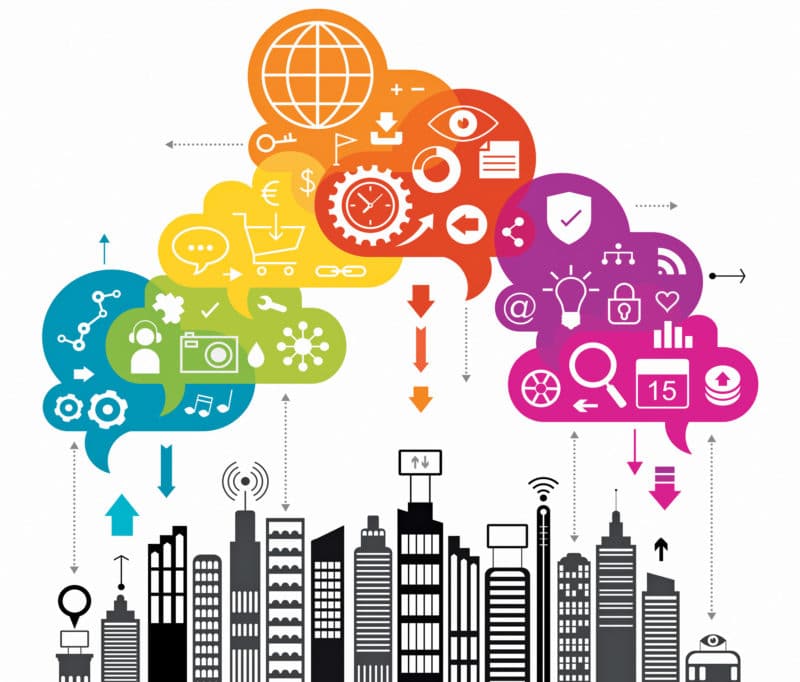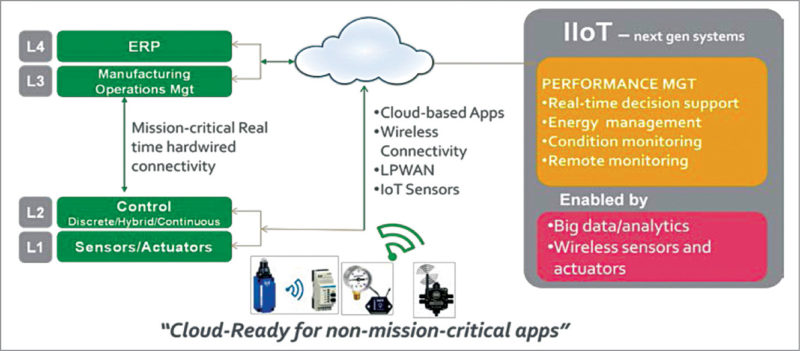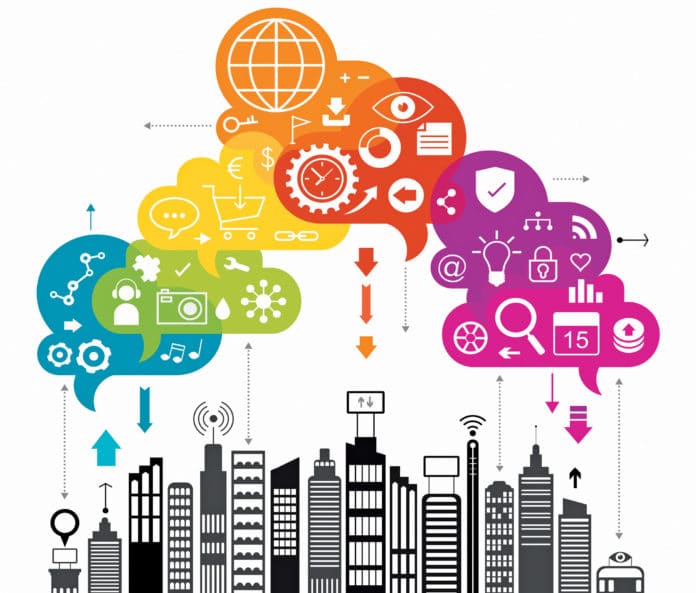The IoT has the power to transform the businesses of any industry. It can improve employee efficiency, deliver better customer experiences, and track supply chain, assets and operations. IoT networks connect people, processes and applications so that businesses can quickly adapt to changing conditions.

Our needs have evolved beyond the basic necessities of food, shelter and clothing. We have developed a number of devices to make our lives simpler and better. We want easy control of devices around us, and do not want to wait in queues to pay toll taxes or utility bills. We want to monitor our health status, track our assets and vehicle movements from a single device.
As technology grows, IoT solutions will change the way we live, work and do business. The IoT is a combination of hardware, like sensors, connectors and gateways, and application software in a single system. IoT devices can communicate with each other and also with an IoT hub, which could be a mobile app or a server. A hub collects data from devices and analyses it to provide meaningful output to users.
Benefits of IoT solutions for businesses
The tiny sensors can be attached to everything from LED bulbs to self-driving cars. These record and send data to the cloud. This allows collecting specific feedback on how products or equipment are used, their lifespan and future requirement of users. It also helps companies make smarter products, enable smarter business operations and make smarter decisions.
The driving philosophy behind the Industrial IoT (IIoT) is that, smart machines are good at accurately and consistently capturing and communicating data. This data enables companies detect reasons for inefficiencies and problems sooner, saving both time and money.
Enhanced flexibility, higher speed and increased efficiency in the production process are the objectives of adapting IoT solutions for businesses. Development and adoption of the IoT are being driven by multiple factors, including easily available low-cost sensors, increase in bandwidth and processing power, wide usage of smartphones, availability of Big Data analysis tools and scalability of Internet Protocol version 6 (IPv6).
Enterprises are adopting IoT solutions for their benefits that include reduction in cost, optimisation in operations and improvement in efficiency. They are now starting to focus on improving services and customer experiences with IoT-connected solutions.

Impact of the IIoT on the manufacturing industry
In the IIoT, multiple devices are connected by communications software to collect, monitor, exchange, analyse and instantly act on information, to intelligently change their behaviour or their environment, all without human intervention. Connected things in the IIoT provide tremendous opportunities to increase performance and lower cost by leveraging sensor data, machine-to-machine (M2M) communication and automation technologies.
The IIoT has significant potential to improve automation, industrial control, quality control, supply chain traceability, overall efficiency and asset performance. Manufacturing, workflows, supply chains and business processes are becoming more intelligent, flexible and dynamic. These are being improved through self-optimisation and autonomous decision-making by using Big Data analytics and deep learning by predicting failures or misalignments on production lines.
Businesses are increasingly relying on digital twins integrated with advanced analytics to improve operations. Digital twins enable business leaders to predict plant performance, ageing patterns, anomalies and future behaviour. These carry deep domain knowledge of specific industrial assets from which the twins can display models.
Digital twins acquire a massive amount of design, manufacturing, inspection, repair, online sensor and operational data feeds through continuous monitoring. With various computational physics-based models and advanced analytics, these determine asset health, performance and lifetime.
Digital twins can also run on cloud-based industrial platforms, which are designed to take and analyse machine sensor data. This improves product design and manufacturing with connected real-world sensor data.
Eric Farrugia, vice president – strategic marketing, industrial controls and drives, Schneider Electric, says “The IIoT is blurring the boundaries between physical and virtual objects. It provides more flexible models of accessing process and machine data. Generating and collecting data alone will not enable manufacturers to realise the full benefit of the IIoT.
There are other components to consider, such as an open and collaborative environment to allow partners to develop a common platform, smart connected devices to generate information, edge gateway to aggregate data, display information and connect to the cloud for advanced analytics, and applications to further analyse data to help reach business goals.”
Developments in wireless technologies empowering the IoT businesses
Wireless technologies are driving Industry 4.0, taking productivity and efficiency to new levels. As a result, wireless connectivity is becoming even more business- and mission-critical, leading to very strict requirements with respect to reliability, low latency and security. Next-generation wireless technologies such as 5G for ultra-reliable, low-latency communications will become crucial to meet all these requirements.
End applications drive growth in different sectors, including healthcare, IT, telecommunications and automotive. Both short- and long-range technologies are addressed as per the need of the business. Bluetooth and Wi-Fi technologies are for short range in unlicensed bands, and longer-range LTE, NB-IoT, and LTE Cat M1 and M0 in licensed bands.
M2M communication in the IoT requires reliable data collection and uninterrupted data transmission. There are primarily three types of wireless communication technologies helping IoT devices in communicating data. These are:
- LTE-M and NB-IoT networks that were developed to support IoT devices even in the most challenging environments, such as underground and deep inside buildings. These have extended battery life and enhanced coverage. Licensed spectrum eliminates the potential for signal interference and dedicated spectrum optimised for the IoT with carrier-grade security.
- Global SIMs that deploy and control connected devices easily and quickly, and automatically and remotely connect to the network for provisioning IoT assets worldwide. These are based on GSM standard for high-speed wireless delivery. There is a standard interface for deploying and connecting mobile and fixed assets. Simple and cost-effective device management can be done with integrated SIMs, which have global roaming in over 200 countries and territories.
- Satellite connectivity that gives greater control of assets, no matter how distant and remote. It manages high-bandwidth demands in mobile and fixed locations. Three solutions built to fit needs include dual-mode, satellite-only and satellite-backhaul. Their usage-based pricing models have greater cost efficiencies.
Staying connected is important for businesses for processing payments to analysing data, as business continuity can be compromised in network failure in the event of Internet outages. Choosing and integrating the right components for a complete IoT solution is a challenge.

The Industrial Internet Consortium (IIC) and OpenFoG Consortium are trying to accelerate the adoption of the IIoT, fog and edge computing, to address bandwidth, latency and communications challenges associated with the IoT, 5G and artificial intelligence (AI) applications. Their mission is to create and validate a framework for efficient and secure information processing between endpoints, cloud and services.
Growth opportunities for the IoT – T&M industry
With the IoT coming into prevalence, the world is becoming increasingly connected, and companies providing IoT testing services are emerging. From security systems and appliances to new and emerging devices, all are getting connected over the Internet. The growing market for the IoT has created a number of business opportunities.
Very strict coverage requirements call for smart testing in IoT applications where devices have to operate under difficult coverage conditions. It requires comprehensive testing of the final device design under real-world conditions in various operational modes.
Opportunities in IoT products testing will grow, and companies that focus on quality will ultimately be the brands that win.
With over-the-air (OTA) firmware updates through connected devices, it is possible to perform baseline functional and compliance testing, and ship products as soon as possible.
This also helps fix any issues that pop up through regular updates. Reliable testing of interference, conformance with standards and regulations, latency and power consumption play an important role here. This reduces time-to-market, increases demand and improves quality of products.
The technology shift towards 5G will require a massive amount of testing for connected cars and autonomous vehicles, too.
IoT solutions for connected businesses
The IoT has the power to transform the businesses of any industry. It can improve employee efficiency, deliver better customer experiences, and track supply chain, assets and operations. IoT networks connect people, processes and applications so that businesses can quickly adapt to changing conditions. Given below are a few IoT solutions required by every industry.
- Cloud hosting provides simple scalability for IoT apps.
- IoT solution management answers needs with end-to-end support for selling, storing and managing IoT solutions. This includes connectivity services, devices, applications, connectivity management, analytics platforms, billing, and device movement control for asset and object tracking.
- IoT security management secures IoT environments. It helps identify things in the connected world and ensure that these are used only by authorised users, devices and applications. It also provides authentication and authorisation for secure communication between sensors. It helps organisations maintain end-to-end supply chain integrity using enterprise-grade encryption technologies and management capabilities.
- IoT device manufacturing and maintenance can be done through Android app development for IoT applications, such as an IoT-connected solution for industry automation and connected vehicles.
Rajkiran, director, Thingworx OEM Business, says, “In the future, solution providers who use application-development platforms will be in a commanding position to drive their businesses. If they can create the right application for the right industry, they will be able to work on that use case and update the application for other purposes in a matter of hours.”
Business opportunities in the development of smart cities and smart buildings

The IoT is transforming smart buildings to develop smart cities at a rapid pace. Organisations are seeking opportunities to enter new markets, develop new products and drive differentiated customer experiences with the IoT.
Smart cities and smart buildings have several business opportunities in data monetisation, connected products and experiences, smart monitoring, asset management and optimisation. Remote structure monitoring from anywhere in addition to re-use of sensors on multiple locations help build better buildings. A connected home makes devices such as coffee pots, appliances and security cameras more useful to improve a consumer’s life.
A smart building is comparatively easier to design and maintain as compared to a smart city. A smart city needs more cost-efficient municipal services, enhanced public transportation, good health facilities and, most importantly, a secure place to live and work. Smart city technology generates a significant amount of valuable data that need to be harnessed, analysed and acted upon.
Use of the IoT in the energy sector improves production, reduces cost, increases worker safety and improves electrical efficiency with IoT energy solutions. Smart grids and meters monitor and control unnecessary usage of electrical systems. This has made possible remote data management and monitoring, automation and control, systems for effective transmission and distribution networks.
Energy bills based on actual consumption improve the billing process and contribute to improved cash flow. Smart metering is also an enabler for new prepaid energy services that can be offered to customers who lack the funds for an up-front deposit or high pre-payments.
Easily-connected health devices remotely monitor and manage patients, and get real-time analysis of data.
IoT devices help get real-time visibility for road conditions and preventative maintenance capabilities for connected cars, roadways and transit systems.
These also help employers ensure worker safety and enhance overall workplace security. Embedded sensors and wearables continuously monitor workers in high-risk environments, like mining, heavy industries and construction, and warn against falls and exhaustion.
Connected video surveillance cameras monitor office premises and ensure protection of important assets.
The IoT enables users to connect different edge devices with each other and operate on them seamlessly, from a remote location with IoT solutions.
Smart irrigation systems and digital dairy practices in rural areas have further increased growth opportunities.
Retailers can manage inventory in real time. Sensors and IoT mobile applications offer market insights that elevate customer experience, enhance convenience levels, and influence online and in-store behaviours.
Choose the right IoT solutions for your business
Every sector requires the power of the latest technologies to easily resolve complex problems and deliver simpler solutions. From tracking the flow of people and traffic density to monitoring fluctuations in office temperature, crop moisture levels or vital signs of patients, solutions are needed to manage over multiple data points. Selecting the wrong components, software or network technology can make IoT projects less likely to be successful, more expensive, and harder to manage and sell.
With careful strategy and planning, adoption of IoT solutions can result in large benefits for businesses by leveraging quick processing, storage and retrieval of data. The IoT can provide a wide range of improvements, from ensuring better control over production and costs to development of new offers. It takes businesses to the next level by enabling more proactive decision-making.









